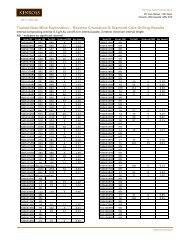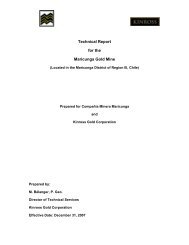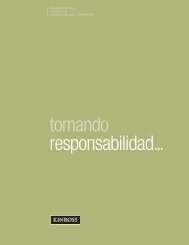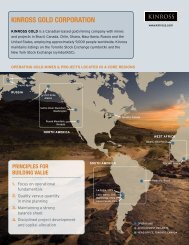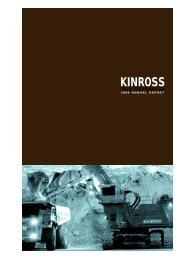Technical Report for the Fort Knox Mine - Kinross Gold
Technical Report for the Fort Knox Mine - Kinross Gold
Technical Report for the Fort Knox Mine - Kinross Gold
You also want an ePaper? Increase the reach of your titles
YUMPU automatically turns print PDFs into web optimized ePapers that Google loves.
<strong>Fort</strong> <strong>Knox</strong> <strong>Mine</strong> <strong>Technical</strong> <strong>Report</strong>17.2.9 Interpolation MethodologyThe “07d” block model was interpolated from <strong>Mine</strong>Sight Compass Multi-Run “06b IDW”developed in 2006. <strong>Gold</strong> grade is projected into model blocks from 30-foot benchcomposites with a series of interpolation runs using an ID 2 algorithm. In <strong>the</strong> first set ofinterpolations, <strong>the</strong> granitic host is modeled in <strong>the</strong> west, middle and east domains. <strong>Gold</strong> isinterpolated with 250x150x75-foot search radii <strong>for</strong> <strong>the</strong> granitic host in <strong>the</strong> west, middle,and east domains and 200x200x200 <strong>for</strong> <strong>the</strong> schist domain. In <strong>the</strong> second pass, whichoverwrites <strong>the</strong> first pass, gold is interpolated with 150x100x75-foot search radii <strong>for</strong> <strong>the</strong>granitic host in <strong>the</strong> west, middle, and east domains and 110x110x110-foot search radii<strong>for</strong> <strong>the</strong> schist domain. The domains were assigned “soft boundaries” between <strong>the</strong> granitedomains, allowing interpolation across <strong>the</strong> domain borders. However, <strong>the</strong> schist-granitedomain boundaries were “hard”, and so composites in <strong>the</strong> granite were not used ininterpolation of schist blocks, and vice-versa. The number of composites <strong>for</strong> a block is aminimum of 3 and maximum of 8. The maximum number of composites per hole is 4.The maximum 3-D search distance <strong>for</strong> composites greater than or equal to 0.300 ounceper ton gold was set at 25 feet.Schist blocks had <strong>the</strong>ir gold grades assigned a zero value. Operational experience hasshown that <strong>the</strong> very small zones of mineralized schist are difficult to identify during orecontrol. There<strong>for</strong>e, it was considered appropriate to discard from <strong>the</strong> estimate any orecontained in <strong>the</strong> schist, which represented approximately 1% of <strong>the</strong> total ore.Drilling in 2007 added 41 holes to <strong>the</strong> 2007 “07d” model bringing <strong>the</strong> total number ofholes to 751 versus <strong>the</strong> 710 utilized in <strong>the</strong> 2006 “06b” model. The search parametersand variography generated <strong>for</strong> <strong>the</strong> 06b were utilized <strong>for</strong> <strong>the</strong> 07d model. Figure 17-4presents <strong>the</strong> 2006 histogram frequency plot and statistical summary of <strong>the</strong> interpolatedblock model grades <strong>for</strong> item “AUID” in <strong>the</strong> “07d” model.17.2.10 Search ParametersFGMI geologists and resource modelers established <strong>the</strong> ellipsoidal search directionsbased on blast hole and structural data in December 2004. The ellipsoidal search59



